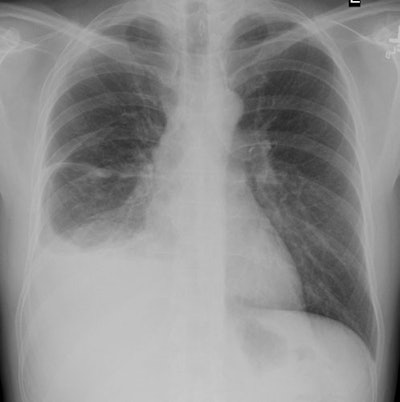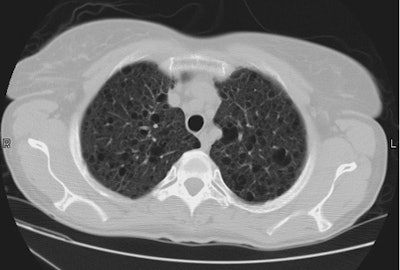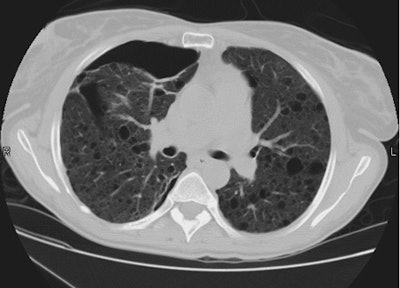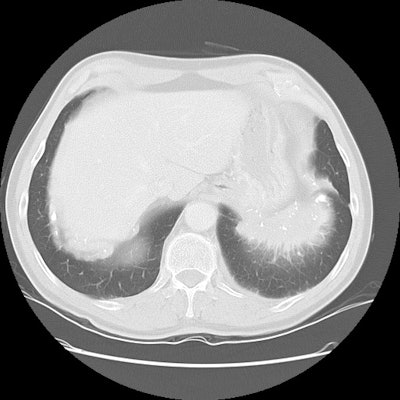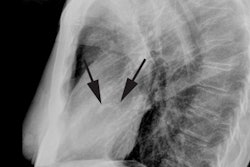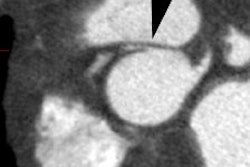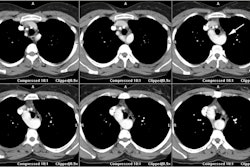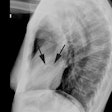Double Aortic Arch:
Clinical:
A double aortic arch is the most common vascular ring (accounting for 50-60% of vascular rings [1]) and it is generally an isolated anomaly not associated with an increased incidence of congenital heart disease [3]. The trachea (anterior indentation) and esophagus (posterior indentation) are encircled by the ring. The most common form of double arch is one in which the right (posterior) arch is dominant (75% of cases) [1]. A left (anterior) arch is dominant in about 20% of cases, and the arches are the same size in 5% of patients [1]. A double arch is usually a very symptomatic lesion which presents early in life with stridor, wheezing, cyanotic attacks, recurrent URI's, and dysphagia. Differential consideration include a right aortic arch with an aberrant left subclavian artery, and a left sided ductus arteriosus to the left pulmonary artery, but this is very rare. As previously mentioned, the condition is rarely associated with CHD, but when present, tetralogy of Fallot is the most common disorder, followed by transposition of the great arteries [4].The left 4th arch usually forms the aortic arch, while the right 4th arch usually regresses and forms the proximal portion of the right subclavian artery. A double arch occurs due to persistence of the right and left aortic arches and a failure of disintegration of the connection between the 4th aortic arches. The left arch is typically anterior to the right arch and trachea, while the right arch is typically superior. The two arches join posteriorly to form a single descending aorta- usually on the left (he descending aorta is typically opposite the dominant arch [4]). Each arch gives off its respective carotid and subclavian arteries.
In incomplete double aortic arch with distal left arch atresia, there is a residual fibrous cord present in the distal left arch which does not completely involute [2]. When the atretic portion occurs distal to the ductus, the remnant fibrous cord forms a complete ring and inserts in a diverticulum of the descending aorta [2]. When the atresia occurs between the ductus and the left subclavian, this also forms a ring with the fibrous cord also inserting in a descending aortic diverticulum [2].
When the involution occurs in the same region in the contralateral left arch, a right aortic arch with mirror image branching results [2]. In almost all cases the involution occurs between the left ductus and the descending aorta and there is no vascular ring [2]. In rare cases, the involution occurs between the left subclavian artery and the left ductus which results in a right arch with mirror image branching and a left ductus connecting a diverticulum from the descending aorta to the left pulmonary artery which produces a potentially symptomatic vascular ring (type II right aortic arch) [2].
X-ray:
On plain film the aortic arch is noted to be right sided. The right arch is larger, posterior, and more cephalad than the left arch in two-thirds of patients [3]. On barium swallow a "Reverse S" impression on is noted on the esophagus- the higher, larger indentation is the result of the right arch, while the lower and smaller impression (on the left side) is due to the left arch. The descending aorta is usually contralateral to the dominant arch [3].
|
Double aortic arch: The patient shown below had a retrotracheal density (black arrow) seen on the lateral view. A CT scan was ordered to further evaluate this finding. |
|
|
|
Double aortic arch: On CT imaging, a complete ring from a double aortic arch was seen encircling the trachea and esophagus (white arrows). |
|
|
|
Double aortic arch: A 3D reconstruction image nicely demonstrates the vascular ring. Click image to view cine file. |
|
|
REFERENCES:
(1) Radiographics 2010; Kimura-Hayama ET, et al. Uncommon congenital and acquired aortic diseases: role of multidetector CT angiography. 30: 79-98
(2) AJR 2005; Schlesinger AE, et al. Incomplete double aortic arch with atresia of the distal left arch: distinctive imaging appearance. 184: 1634-1639
(3) J Cardiovasc Comput Tomogr 2010; Kanne JP, Godwin JD. Right
aortic arch and its variants. 4: 293-300
(4) Radiographics 2017; Hanneman K, et al. Congenital variants and anomalies of the aortic arch. 37: 32-51
